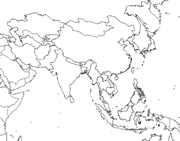
Click for printable map of Asia
(Browse all the other World Maps.)
Map of Asia links to other maps
- Printable – A map of Asia with the countries labeled.
- Outline, Unlabeled
- Political with Shaded Relief – (click on the map to enlarge)
- Central and Northern Asia Political – (PDF, black & white)
- South Asia Political – (PDF, black & white)
- Roads – Go to MapQuest, choose a country and enter a city.
- Weather – Northern Asia
- Weather – Southern Asia
- Earthquake Activity
- Languages – (click on “South Asia” or “South East Asia”)
- Flags – Click on the map of Asia to see each country’s flag
- eBook Maps – Free eBook maps for your eBook device.
- Physical Map – (click on the map to enlarge)
Asia Of Interest
Asia is the largest of the world’s seven continents at 31,027,230 square miles. It is home to the highest point on Earth, Mount Everest (Nepal, Tibet), at 29,032 feet. The lowest point, the Dead Sea (Israel, Jordan), is 1348 feet below sea level and is the second-lowest point on all the continents (the lowest point is 8,327 feet below sea level – the Bentley Subglacial Trench in Antarctica).
Asia is more a geographic term than a separate continent as it is the eastern 80% of the giant Eurasian landmass. It has the greatest range of land elevation of any continent and has the longest coastline. It has the world’s widest climatic extremes, and as a result, harbors the most varied forms of vegetation and animal life on Earth.
Asia’s population is approximately 3,600,000,000 spread over its 47 countries. More than 50 languages are spoken there. The largest country by area is Russia with 4,845,580 square miles. The largest country in Asia by population is China with more than 1 billion people. Asia has the third longest river in the world – the Yangtze River at 3,964 miles. The Gobi desert in Asia is the world’s third largest non-polar desert with 500,005 square miles and the largest lake in Asia is the Caspian Sea at 143,244 square miles.
The mountain systems of Central Asia have formed a natural barrier that has contributed to the movement of peoples into the area. As a result, Asia’s population is unevenly distributed. There is a concentration of population in western Asia as well as great concentrations on the Indian subcontinent and the eastern half of China. Other highly populated areas are the Pacific borderlands and on the islands, but large areas of North and Central Asia have remained sparsely populated. Even with this population distribution, Asia is the most populous of the continents, containing nearly 60% of the world’s people.
See related information at United States Maps
Browse all the other World Maps.